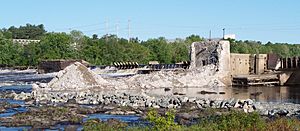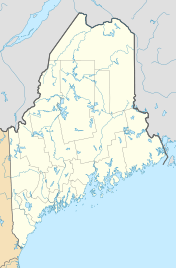Great Works Dam facts for kids
Quick facts for kids Great Works Dam |
|
|---|---|

Great Works Dam during week 1 of demolition
|
|
|
Location of Great Works Dam in Maine
|
|
| Country | United States |
| Location | Penobscot County, Maine |
| Coordinates | 44°55′14″N 68°37′58″W / 44.92046°N 68.63275°W |
| Opening date | 1900 |
| Demolition date | 2012 |
| Dam and spillways | |
| Impounds | Penobscot River |
| Height | 20 ft (6 m) |
| Length | 1,426 ft (435 m) |
| Power station | |
| Decommission date | 2012 |
| Installed capacity | 8 MW |
The Great Works Dam was a large structure on the Penobscot River in Maine, USA. It was located between the towns of Old Town and Bradley. The first dam was built here in the 1830s. A newer, bigger dam replaced it between 1887 and 1900. This dam was important for local industries for many years. However, its story changed in 2012. On June 11, 2012, the dam began to be taken down. This was part of a huge project to help fish return to the Penobscot River.
Contents
What Was the Great Works Dam?
The Great Works Dam was a big wall built across the Penobscot River. It was about 20 feet (6 meters) tall. It stretched for 1,426 feet (435 meters) across the river. The dam was first used by a company called Penobscot Chemical Fibre. Later, it was owned by other companies. For a long time, the dam helped power a nearby mill. It also helped control the river's flow.
How Did the Dam Change Hands?
The dam and its power plant were sold many times. In 1968, Diamond International Corporation bought it. Later, in 2010, a group called the Penobscot River Restoration Trust bought the dam. This group had a special plan for the river. They wanted to make the river healthier for fish.
Why Was the Dam Removed?
Dams can block the natural path of fish. Many fish, like salmon and sturgeon, live in the ocean but swim up rivers to lay their eggs. These are called "sea-run" fish. The Great Works Dam, and others on the Penobscot River, stopped these fish. They could not reach their old spawning grounds. This caused their numbers to drop.
Helping Fish Migrate
Scientists and environmental groups wanted to help these fish. They knew that removing dams could open up miles of river. This would let fish swim freely again. The Great Works Dam was a key barrier. Taking it down was a big step. It would help eleven different kinds of sea-run fish.
The Penobscot River Restoration Project
The removal of the Great Works Dam was part of a much larger plan. This plan was called the Penobscot River Restoration Project. It was a huge effort to bring the river back to life. The project involved many groups working together. They included Native American tribes, conservation groups, and government agencies.
A Big Plan for the River
The project had a few main goals:
- To remove some dams completely.
- To build special "fish bypasses" around other dams. These are like fish ladders.
- To make sure enough electricity was still made. This was done by making other power plants more efficient.
The Great Works Dam was one of four dams involved. Its removal was a major part of the project.
A River Reborn
After the Great Works Dam was taken down, big changes happened. The river began to flow more naturally. Fish started to return to areas they hadn't been able to reach for over 100 years. This project is a great example. It shows how people can work together to fix environmental problems. It helps nature heal and thrive again.


